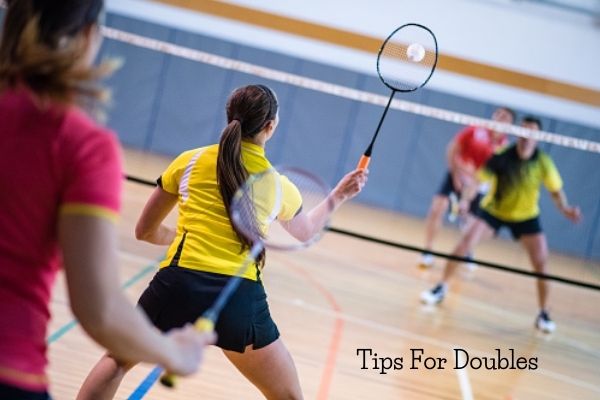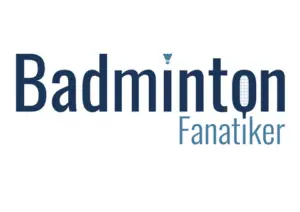In Badminton, doubles has an extremely different style of play than singles. It is often more complex as it involves the coordination of two players. In professional badminton, it is rare to see a player compete in both singles and doubles.
Training for singles and doubles is different in all aspects. Doubles is faster, sharper and the players must be extremely fast to excel in the game. Effective footwork and coordinated formations are the key elements in doubles.
Whether you are a beginner or a professional player, here are a few tips that will help you to enhance your game in doubles.

Communication
In professional matches, you might have seen the doubles partners communicating with each other before a serve. You might be wondering why do they do that? Well, using a variety of serves such as a flick serve, drive serve can help to trick the opponent.
Therefore, to make the partner ready for a particular type of serve return, communication is a must. Otherwise, if your partner is not ready for the return, your team may lose a point. You and your partner can design different signals to communicate with each other.
For example, you can signal 1 behind your back for a flick serve or 2 for a drive serve. By doing this, you and your partner will be prepared for the return of the service and sometimes, you can intercept the return as well.
Serve And Receive
Well, these two strokes are the most important element in doubles. The aim in doubles is to keep the shuttle as low as possible. Moreover, the placement of a service or return can decide whether you will win the point or not.
It is really important to learn the different types of serves in badminton and how to return serves correctly.
The quicker you force a weaker return from your opponent, the higher chance you will get to attack and win the rally.
Formations
There are two types of formations in doubles.
- Attacking formation
- Defensive formation
Master these two formations to improve your performance in doubles. In the attacking formation, the attacker must move at the back of the court and the setter in front of the court. You may be wondering when to use this formation?
The answer is whenever you manage to force your opponents to execute a lift shot to you, you and your partner must quickly shift to an attacking formation. Again, communication is a key element here. Communicate with your partner so that there is no confusion as to who will go behind and front.
In this formation, you and your partner will have two different roles.
- The setter (player in the front) will secure the net position and apply pressure from the net area to force the opponent to continue forcing lifts from the opponent.
- If the opponents hit a poor-quality lift, the setter will intercept the lift with a smash.
- The attacker (player at the back) has one important role that is hit powerful smashes.
In simpler terms, the attacker will cover the back of the court and the setter will cover the frontcourt.
Conversely, when you execute a high lift or a high clear, you and your opponent must move to a defensive position.
In this formation, you and your partner must be side by side in your respective half courts. Both of you must be prepared to defend your opponent’s powerful smashes.
What is Block Defence?
A block defense is a very important shot in doubles. It is practiced when you are defending your opponent’s powerful smashes. To perform a block defense, you receive your opponent’s smash by lifting the shuttle high, straight to the opponent’s baseline.
Executing smashes from the baseline is difficult so when you keep using block defense, it takes more energy from the opponent. It must be high enough to prevent your opponent from intercepting and hitting a half-court smash.
Most importantly, always stay on your toes as when you have your feet rooted to the ground, it will limit your movement in the game.
If you want to learn more about the formations in badminton doubles, check out this article.
Maximum Attacking
In doubles, lifting or clearing is not always an ideal option. It brings you and your partner in a defensive position and at some point, in time, it puts you at a disadvantage to be in a defensive position.
Instead, practice net shots, drives, and half-court push that will keep your opponent in a defensive position which will provide you and your partner maximum chances to win the rally.
However, under pressure situations, it is recommended to hit a lift or a clear shot as it will give you and your partner time to recover and be ready for the next shot.
Movement
Unlike singles, doubles involve the movement of two players across the court. Good chemistry and coordination form a perfect doubles partnership. Both you and your partner must be able to quickly change from an attacking to a defensive formation or vice versa effectively.
You must be ready to take an extra effort to reach the shuttle and not give up. This requires quick movement across the court.
Otherwise, this can lead to confusion and you may lose the rally. Practice these formations and communicate while doing so to speedily improve your performance.
Aim At The Middle Of The Court
An effective practice in doubles is to aim a particular shot in the middle of the court when you are in an attacking position. At this point, your opponents are in the defensive position and are standing side by side.
This will force your opponents to make a quick decision as to who will receive the shuttle. Eventually, a moment of indecision can make them lose a point.
Another instance is when you pretend to hit a smash and instead hit a drop shot in the middle of the court. This again confuses the opponents which can act as an added advantage to your game.
Trust And Understanding
The most important tip for playing doubles is to trust and understand your partner. This is the foundation of any doubles partnership.
In doubles, the role of the two players is mostly well defined. While the attacking player hangs back to smash, the defensive player controls the net. Therefore, do your job and trust your partner to do his/her job. Don’t focus on what your partner isn’t doing, instead, look at the positives of your partner.
Read Between The Lines
Doubles is a game of speed, power, strength, and most importantly, skills. You and your partner must be able to adapt to different challenges presented by your opponent’s strokes. The ability to understand the playing pattern, strengths, and weaknesses of your opponents is important in doubles as it gives the opponents little breathing space.
Enjoy The Game
In badminton, doubles is equally as important as singles. Under pressure situations, you may get frustrated which will affect your game and also your partner. Therefore, be patient and enjoy the game with your partner. Whether you lose or win, it should not affect your partnership and coordination.
Final Thoughts
The above tips will help to improve and develop your game. However, to get the best version of yourself on the court, keep practicing. Increase your training hours with your partner. This will help you become more comfortable with each other which will make it easier to trust and coordinate with your partner.
Training and tactics will push you to become a good doubles player. You have to be dedicated, disciplined, and diligent to push yourself on the court to get your desired results. Prepare for longer rallies and love the game and your practice sessions.
I hope this article was helpful to you. Thanks for reading!

